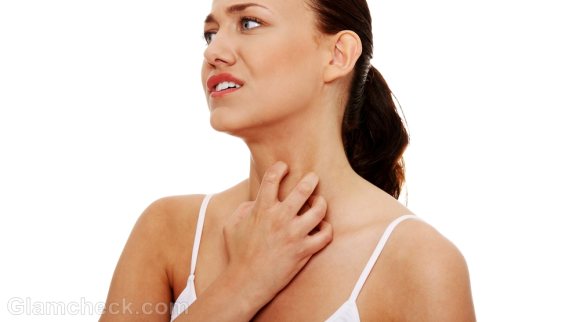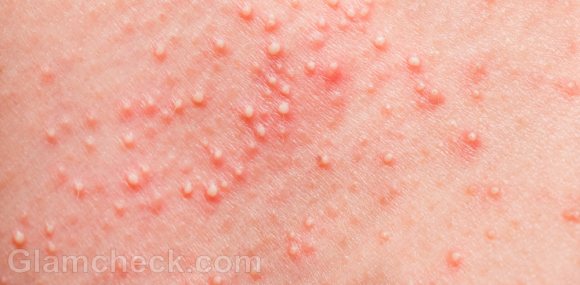As the name implies, heat rash is nothing more than a rash that is caused by extreme hot weather. Heat rash is also known as prickly heat or milaria. You may have seen or heard of babies with heat rash. However, adults are just as much affected by this condition.
Heat rash is not a dangerous medical condition, but it can make you very uncomfortable. Plus, heat rash mars the appearance of your skin. Let’s take a closer look at this troublesome skin condition.
What is Heat Rash?
 One of the tasks your skin performs is to maintain your internal body temperature. It does this with the helps of sweat glands and sweat ducts which are located underneath the skin all over your body. When the temperature rises, the sweat glands are triggered and you start to sweat. As you sweat, the heat is released through the sweat that is deposited on the surface layer of skin, thus bringing your body temperature under control. This is a very important function of the skin because the body is like a highly sophisticated computer system which will only work best under the right temperatures.
One of the tasks your skin performs is to maintain your internal body temperature. It does this with the helps of sweat glands and sweat ducts which are located underneath the skin all over your body. When the temperature rises, the sweat glands are triggered and you start to sweat. As you sweat, the heat is released through the sweat that is deposited on the surface layer of skin, thus bringing your body temperature under control. This is a very important function of the skin because the body is like a highly sophisticated computer system which will only work best under the right temperatures.
Heat rash occurs when the sweat ducts get blocked somehow and prevent the sweat from reaching the surface of the skin to evaporate. The sweat gets trapped under the skin, thus causing a slight inflammation or a mild rash.
Types of Heat Rash
The types of heat rash are classified depending on the severity of the condition as well as the appearance of the rash itself.
1.Milaria crystalline is the most basic type of heat rash where the blisters are almost transparent and are only on the surface of the skin. There is not much pain or itching with this type of heat rash.
2. Milaria pustulosa involves heat rash with white or yellow bumps or blisters.
3. Milaria rubra will have red bumps or blisters. This is the one people are actually talking about when referring to prickly heat. The heat rash here occurs in the deeper layers of the skin.
4. Milaria profunda is when the bumps or blisters of the heat rash take root deep in the skin. This is a rare form of heat rash, but one of the more dangerous ones as it can prevent the sweat glands from doing the job thus leading to other complications.
Complications of Heat Rash
As mentioned before, heat rash is not a condition that is going to affect your health. However, the more severe forms of heat rash like milaria profunda can interfere with your body’s temperature-regulating system which may lead to complications like infection from scratching at the blisters or bumps, headache, heat exhaustion, fever, low blood pressure, nausea, dizziness, and in rare cases, even death
Causes of Heat Rash
We have already seen the heat rash occurs because the sweat ducts get blocked and the sweat gets trapped underneath the skin. With babies, heat rash happens because their sweat glands have not yet developed properly and the body is thus unable to get rid of the sweat. But it is still unknown why heat rash affects some adults more than others. However, some risk factors for heat rash have been identified.
- Excessive sweating can cause the sweat glands to get blocked, thus causing heat rash. You may sweat excessively if it is very hot, or you may have a medical condition which causes excessive sweating.
- Slathering on too much lotion or heavy creams raises your risk for heat rash, especially if you live in a tropical climate. Creams and lotions can clog the sweat glands and cause sweat to get trapped under the skin.
- Heat rash can even occur in the wintertime if you bundle up very heavily to keep warm. The multiple layers of clothing can prevent the sweat from evaporating, thus causing it to encapsulate in little blisters on the skin.
- Tight clothing, especially if made from fabrics which do not let your skin breathe, can prevent the sweat from evaporating too thus causing heat rash.
- Areas of the skin with creases – the armpit and groin, for example – are more vulnerable to heat rash as the creases can prevent the sweat from evaporating.
- Some medications like clonidine have heat rash as one of the side effects.
- People who are confined to their beds can also get heat rash if they lie in the same position for a majority of the day and night.
- Obesity greatly increases your risk for heat rash.
- Athletes too are at high risk for heat rash.
- If the climate in general ranges from warm to hot where you live, you are at high risk for heat rash.
Symptoms of Heat Rash
 Regular heat rash has some common symptoms that are easily identifiable.
Regular heat rash has some common symptoms that are easily identifiable.
- Blisters are a common symptom of heat rash. The blister of a heat rash look like little bubbles. This is where the sweat has been trapped under the skin.
- Red lumps are another symptom of heat rash. They may or may not sting when touched. The lumps look like raised red bumps. The surrounding areas of skin will often be red and rash-like.
- Heat rash may be accompanied by severe itchiness.
Worrisome Symptoms of Heat Rash
If your heat rash does not seem to get better in a few days, then you should pay your doctor or dermatologist a visit. Following are the symptoms which justify medical attention.
- Your heat rash does not go away in a few days. The symptoms either stay the same or are getting worse.
- The blisters are full of pus and some of it is starting to drain out.
- Your heat rash is accompanied by a fever or chills.
- In addition to your heat rash, you the nodes in your neck or armpit have swollen up.
Treatment for Heat Rash
A heat rash is nothing to worry about and will generally just go away on its own if you take some simple steps to keep the area of the rash dry and cool. It is best to just leave the affected area alone, stay out of the sun, and wear loose clothing. If you have air-conditioning, leave it on till your heat rash disappears. Or at least sit under a fan as and when possible.
The heat rash should reduce in a few days. If the prickly sensation is too much to bear, you can apply some calamine lotion to soothe the area. Pure aloe vera gel can also help to considerably reduce inflammation, itching, and redness. Buttermilk is another thing you can apply directly onto your heat rash for relief from the worst symptoms.
Some people who have suffered from heat rash claim that taking vitamins C or A can help to reduce the rash quickly. Although there is no medical research to back this up, you can give safely give it a go.
The more severe forms of heat rash may need medical attention, especially if there are signs of infection. Your doctor or dermatologist may prescribe a cream or lotion to soothe redness or itching, some antibiotic medication if you have an infection, and anhydrous lanolin to prevent the sweat ducts from getting blocked. In the worst cases of heat rashes, you may have to resort to topical steroids.
Preventing Heat Rash
Heat rash has quite a few risk factors but not many direct causes. Since it is not known exactly why heat rash affects some people but not others, it is not possible to entirely prevent heat rash. But you can take steps to reduce your risk.
- In the summer, wear loose-fitting clothes made of breathable fabric such as cotton. Stay indoors during the peak hours of sunshine (11 am to 2 pm). If you live in a particularly hot climate, try to avoid activities which will cause heavy sweating. Take cool showers when possible.
- In the winter, avoid bundling up too heavily.
- Switch to soaps that are made from natural ingredients, and which are free of dyes and fragrances. The chemicals used in harsh soaps can clog your pores as well as your sweat glands, thus leading to heat rash.
- If possible, let your skin dry naturally after a bath rather than toweling off.
- Avoid spending too much time in saunas or jacuzzis.
- If you are starting on any new medication, ask your doctor if heat rash is one of the side effects. If it is, you can ask him or her to prescribe an alternative if possible.
- If you are confined to your bed, you are at high risk of developing heat rash. Make sure you move around as much as you can so that the skin all over your body has a chance to be exposed to fresh air. If you cannot move on your own, get somebody to help you. Being bedridden is bad enough without the irritation of heat rash.
Image: Shutterstock
